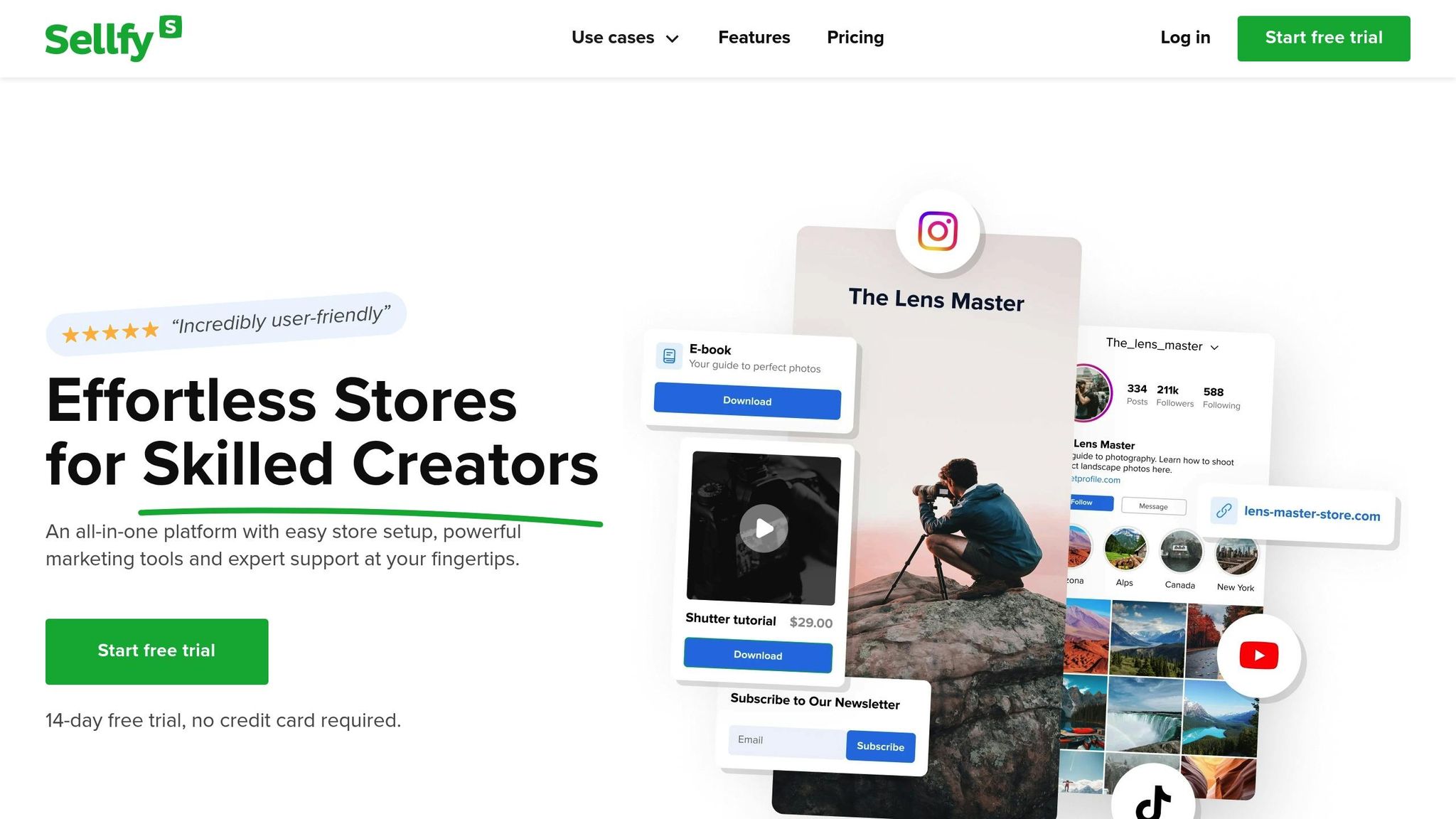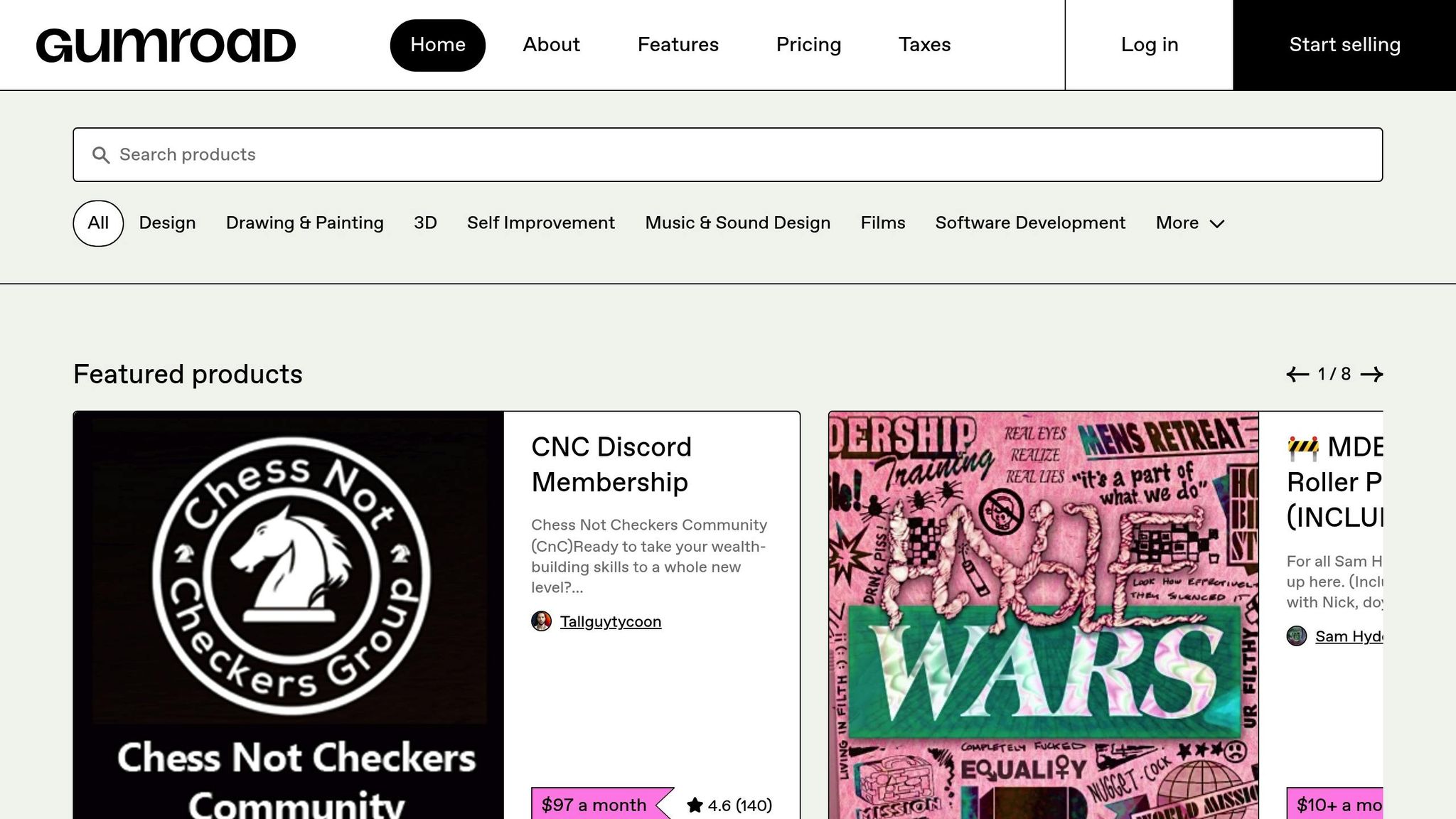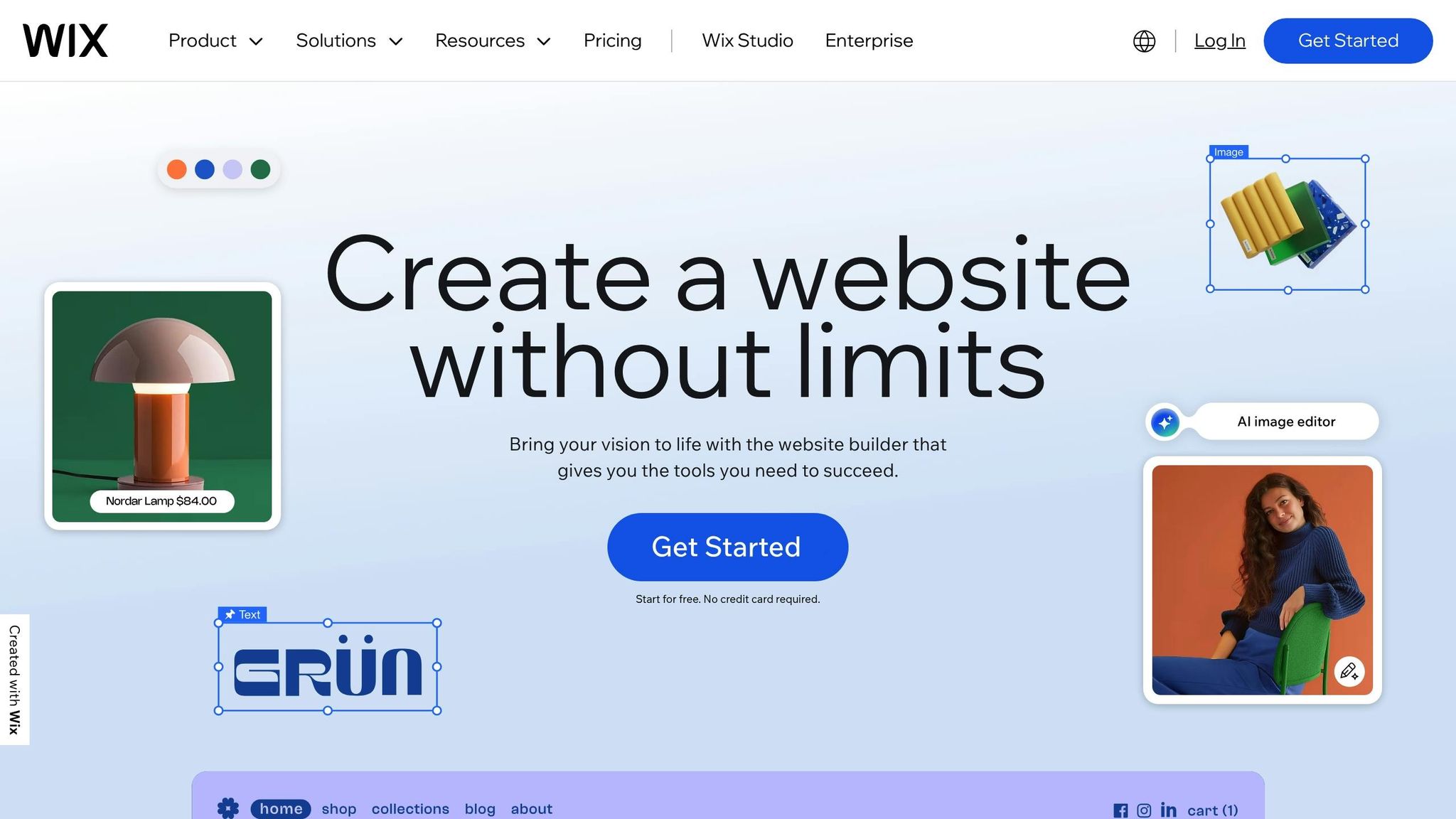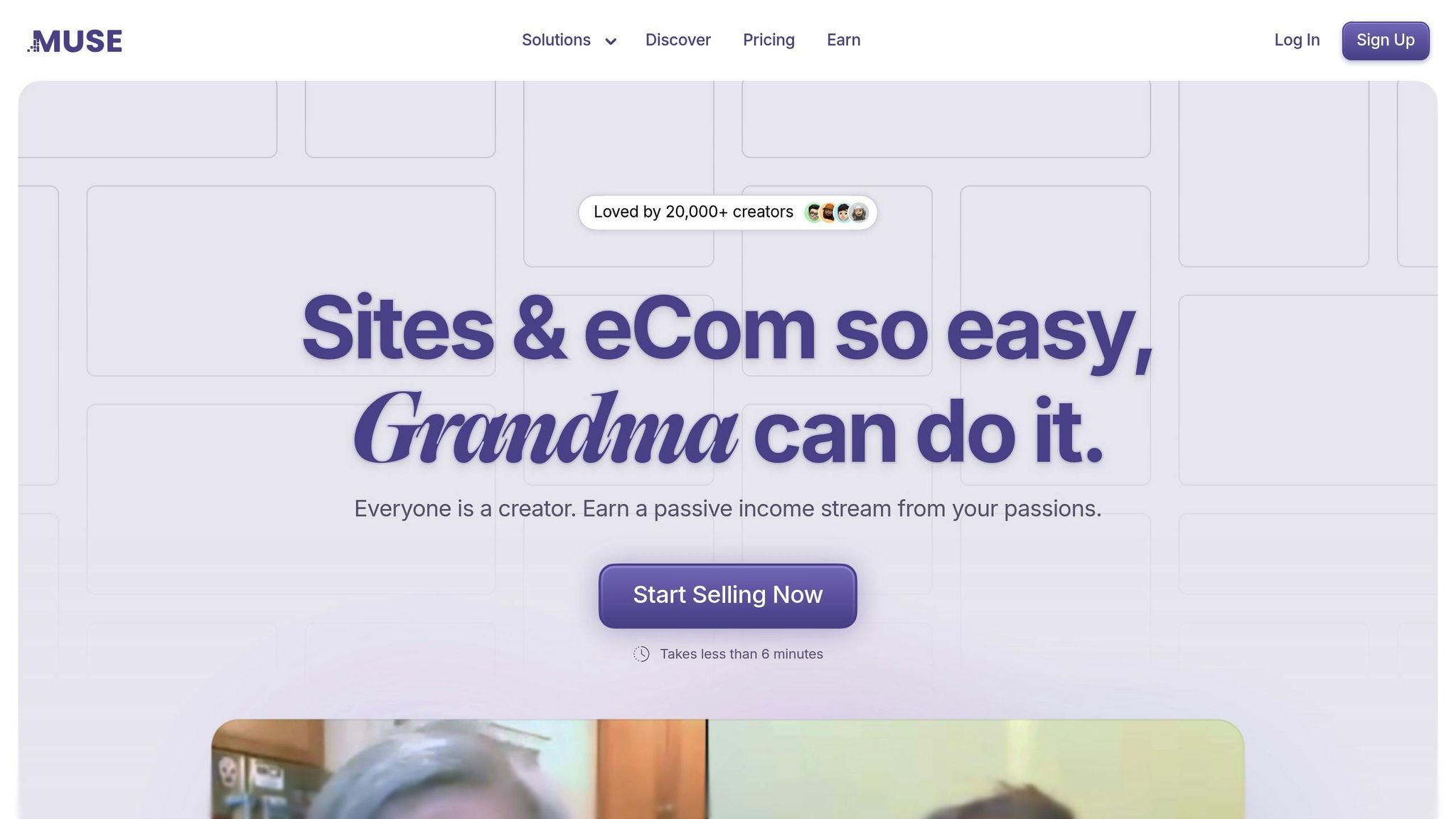Selling digital products online is easier than ever, and choosing the right platform can make all the difference. Whether you're selling eBooks, music files, or templates, here are five popular options to consider:
Complete Sales Platforms (e.g., Sellfy, Payhip, Podia): All-in-one solutions for creators who want simplicity. Prices range from $0/month (Payhip) to $39/month (Podia).
Marketplaces (e.g., Etsy): Great for reaching buyers quickly, but expect higher fees (6.5% transaction fee + others).
Add-on Tools (e.g., Gumroad, Shopify Buy Button): Integrate sales tools into your existing website. Gumroad is free with higher fees, while Shopify starts at $9/month.
Website Builders with Stores (e.g., Wix, Squarespace): Ideal for branding control. Wix starts at $27/month, and Squarespace at $23/month.
New Creator Platforms (e.g., Muse): Emerging tools with audience engagement features. Plans range from free (9% fee) to $60/month (1% fee).
Quick Comparison
Platform Type | Best For | Starting Price | Transaction Fee | Key Features |
|---|---|---|---|---|
Complete Sales Platforms | Simplicity, all-in-one tools | $0–$39/month | 0%–5% | File hosting, memberships |
Marketplaces | Instant audience access | $0.20/listing | 6.5% + other fees | Built-in buyers, search tools |
Add-on Tools | Selling via existing website | Free–$9/month | 2.9%–10% + $0.30 | Easy integration, customization |
Website Builders | Full branding control | $23–$27/month | 0%–3% | Storefronts, unlimited storage |
New Creator Platforms | Engagement + sales tools | Free–$60/month | 1%–9% | AI design, email marketing |
Each platform has its strengths, depending on your goals. If you're just starting, marketplaces like Etsy or tools like Gumroad can help you test the waters. For scaling and full control, website builders or all-in-one platforms are better long-term options.
5 Best Platforms To Sell Digital Products Online (2025)
1. Complete Sales Platforms (Sellfy, Payhip, Podia)

Complete sales platforms are a one-stop-shop for creators who want to sell digital products without juggling multiple tools or services. These platforms handle everything - file hosting, payment processing, and product delivery.
When choosing a platform, creators should focus on key factors like fees and customization options, as mentioned earlier.
Platform | Best For | Starting Price | Transaction Fee |
|---|---|---|---|
Sellfy | Digital creators needing print-on-demand | $19/month | 0% |
Payhip | Beginners with limited budget | $0/month | 5% |
Podia | Course creators and membership sites | $39/month | 0% |
Sellfy, starting at $19/month, combines digital product sales with print-on-demand services, making it a great option for creators looking to diversify their offerings. Payhip, with its free plan (5% transaction fee), is ideal for those just starting out. Podia, at $39/month, is tailored for selling memberships and online courses.
Sellfy stands out with tools for selling everything from eBooks to software. Its built-in print-on-demand service lets creators expand their product range without needing extra integrations.
Payhip is perfect for budget-conscious creators, offering a free plan with a 5% transaction fee that decreases with upgraded plans. It also includes unique features such as:
Pay-what-you-want pricing
PDF watermarking to protect content
Instant payouts via PayPal
For creators focused on memberships and courses, Podia offers advanced features and has already processed over $100 million in sales. Some of its standout features include:
24/7 customer support
Built-in email marketing tools
Easy-to-use course builders
All three platforms ensure secure transactions and include automatic tax compliance tools to simplify financial management.
2. Online Marketplaces (Etsy)
For creators looking to reach buyers quickly, Etsy offers a straightforward way to sell without the hassle of building an audience from scratch. With 96 million active buyers [6] and a strong demand for digital products, Etsy provides a ready-made platform for creators.
Platform Overview
Etsy simplifies digital product sales with features like instant file downloads. It connects creators with shoppers actively searching for items such as printable art, planner templates, and design tools [3].
Fee Type | Amount |
|---|---|
Listing Fee | $0.20 per item (4-month renewal) [7] |
Transaction Fee | 6.5% of sale price [7] |
Payment Processing | 3% + $0.25 [7] |
Offsite Ads | 15% (12% for shops earning over $10k annually) [7] |
These fees reflect a trade-off: higher transaction costs in exchange for Etsy's built-in audience.
Key Benefits
Etsy offers several advantages for sellers:
Built-in buyer trust and protection policies
Secure payment processing
Automatic file delivery (up to 20MB per file) [4]
Search and promotional tools to boost visibility [2]
Protecting Your Work
Etsy includes tools to safeguard creators' digital assets:
Customizable download limits [4]
Unique download links for each buyer [4]
Watermark options for preview images [3]
A system for reporting copyright violations [3]
Success Tips
Successful sellers, like DigitalArtLand (with over 100,000 sales), attribute their achievements to optimized listings, frequent product updates, and bundling offerings [9].
Pricing Strategy
Etsy's massive buyer base allows creators to save on marketing efforts, making the platform's fees more manageable.
"In 2022, Etsy sellers contributed $14.3 billion in economic impact, demonstrating the platform's significant role in the digital commerce ecosystem" [6].
While Etsy is great for reaching buyers quickly, creators who want complete control over their branding might prefer website builders, which are discussed in Section 4. For many, Etsy serves as an excellent starting point or a complementary sales channel.
3. Add-on Sales Tools (Gumroad, Shopify Buy Button)

If you already have a website, add-on sales tools can help you sell directly without starting from scratch. These tools integrate with your site and cover key needs like fees and customization, as discussed earlier.
Gumroad: Keeping It Simple
Gumroad is all about ease of use. Its free plan charges a 10% + $0.30 fee per transaction[11], making it a solid choice for those just starting with digital products. It takes care of essentials like secure file delivery and customer management automatically.
The free plan includes features like pay-what-you-want pricing, affiliate programs, and automated product delivery.
Shopify Buy Button: For Advanced Needs
Shopify's Buy Button offers more robust ecommerce capabilities. It connects with Shopify’s backend while letting you keep your existing website design intact.
Feature Comparison | Gumroad | Shopify Buy Button |
|---|---|---|
Starting Cost | Free (with higher fees) | $9/month |
Transaction Fees | 10% + $0.30 (free plan)[11] | 2.9% + $0.30[5] |
Design Control | Basic options | Extensive customization |
Analytics | Limited tracking | Detailed reports |
Both platforms ensure secure delivery while preserving your website's current look.
User Feedback
User ratings are strong for both platforms (Gumroad: 4.3/5, Shopify: 4.4/5)[9][10].
Making the Right Choice
If simplicity and access to a built-in marketplace (via Gumroad's Discover feature) are important to you[11], Gumroad is a great pick. On the other hand, if you’re looking for advanced features like in-depth analytics or plan to scale up, Shopify Buy Button is the better option. This choice reflects the balance between customization and cost mentioned earlier.
For those who want even more control over their brand, website builders (discussed in Section 4) may be worth exploring.
4. Website Builders with Stores (Wix, Squarespace)

If you're looking to maintain control over your brand while selling online, platforms like Wix and Squarespace offer customizable storefronts paired with built-in tools for digital sales. Both align with the key factors we covered earlier: Wix is great for businesses aiming to grow, while Squarespace keeps things simple and offers unlimited storage.
Wix: Packed with Features for Growth
Wix is a solid choice for sellers looking to scale. It supports up to 50,000 physical and digital products and comes with tools like automated delivery, download limits, and customer location tracking for digital items [1][12].
Plan | Price | Transaction Fee | Key Feature |
|---|---|---|---|
Wix Business Basic | $27/mo | 0% | Advanced marketing tools |
Wix Business VIP | $59/mo | 0% | Priority support |
Squarespace: Simplified Selling
Squarespace emphasizes ease of use and offers unlimited storage on all plans, making it ideal for sellers with large product catalogs [3]. Pricing starts at $23/month for the Business plan, which includes a 3% transaction fee. Upgrade to their Commerce plans to eliminate transaction fees entirely [3].
Both platforms also provide mobile-optimized templates, ensuring your store looks great on any device [1][3].
Which Platform Should You Choose?
Wix: At $27/month, it’s a bit pricier, but the advanced tools and app integrations make it a strong option for sellers focused on growth. If you're planning to scale your business and need robust marketing features, Wix is the way to go [12].
Squarespace: Starting at $23/month, Squarespace is perfect for creators who value simplicity and unlimited storage. Its clean templates and intuitive design tools are especially appealing for those prioritizing aesthetics [3].
For those who need even more specialized features, keep an eye on emerging platforms like Muse, which we’ll cover in Section 5.
5. New Creator Platforms (Muse)

Platforms like Muse are stepping up to meet creators' needs by combining sales tools with features that support audience interaction. Unlike standalone tools (see Section 3), Muse provides a ready-to-use storefront, eliminating the need for an existing website.
Platform Overview
Muse simplifies digital sales and audience engagement with its tiered pricing plans:
Plan | Cost | Fee | Key Features |
|---|---|---|---|
Basic | Free | 9% | 1GB storage, basic storefront |
Premium | $6/mo (billed yearly) | 4% | 10GB storage, email campaigns |
Pro | $60/mo (billed yearly) | 1% | 100GB storage, advanced analytics |
Core Features
Fully customizable storefronts, including AI-powered design options
Support for various product types like courses, member areas, and coaching
Built-in tools for email marketing and performance analytics
Storage options ranging from 1GB to 100GB, depending on the plan
Why Consider Muse
Muse stands out by addressing key creator needs. For instance, its 1% transaction fee on the Pro plan is a better deal compared to Payhip's 5%. Additionally, the AI-powered store builder makes it easy for beginners to create a professional storefront. The platform also emphasizes tools for building a community, which is essential for growing a brand.
Best Use Cases
Muse is a great option for creators who:
Want a single platform for both selling products and engaging with their audience
Offer a variety of digital products like courses, ebooks, and templates
Need a straightforward interface with built-in marketing tools
That said, if you’re looking for complete design flexibility, traditional website builders (see Section 4) might still be the better choice. Muse shines for creators prioritizing simplicity and integrated tools.
Platform Comparison
Using the evaluation framework from the introduction - fees, customization, and growth potential - let's break down how different platforms meet key business needs.
Customization and Control
As we discussed in the website builder analysis (Section 4), how much control you have over your design can influence both how your brand is perceived and how well it converts visitors into customers.
Marketplace Platforms like Etsy offer limited design options but make up for it by connecting you with millions of potential buyers right away. Plus, Etsy’s built-in SEO tools can help new sellers show up in search results faster [8].
Growth Potential
Different platforms cater to different growth stages:
Testing Markets: Gumroad keeps things simple with an easy-to-use interface that doesn’t require design skills. Sellfy, on the other hand, allows for some theme customization, helping you maintain a consistent brand image.
These options reflect the broad opportunities for scaling that were discussed in the market analysis from the introduction.
Marketing and Promotion Tools
Marketing features range from Gumroad’s straightforward coupon system to Shopify’s more advanced multi-channel campaign options.
Setup Complexity
Platform Type | Average Setup Time | Technical Skills Required |
|---|---|---|
Marketplaces | Less than 1 hour | None |
Add-on Tools | 2–4 hours | Basic |
Full Builders | 1–3 days | Intermediate |
This range highlights the tradeoff between how much control you have and how easy the setup process is - similar to the factors outlined in the introduction’s key considerations table.
Summary and Next Steps
Now that we've reviewed various platforms and their features, it's time to move forward with launching your digital downloads business. Your platform choice should align with your current needs while also supporting your future goals.
Implement Your Strategy
Using the evaluation framework covered earlier, focus on these key steps to get started:
Launch Essentials:
Set up clear and informative product pages
Ensure secure payment processing
Provide reliable digital delivery
Establish terms of service [13]
Lay the Marketing Groundwork: Begin with platforms that offer access to built-in audiences as you work on building out your own marketing strategy.
Growth Strategy
To take advantage of the market opportunities discussed earlier, focus on these priorities:
Strengthen your core offerings
Collect and analyze customer feedback
Expand your product range
Invest earnings into focused marketing efforts
FAQs
Which platform is best for selling ebooks?
The best platform for selling ebooks depends on your audience and goals. Based on our comparisons, platforms like Sellfy (Section 1) are great for handling ebook sales, while Etsy (Section 2) is ideal for creators looking for a built-in audience.
Here’s a quick breakdown of top choices:
Platform Type | Best For | Section |
|---|---|---|
Marketplaces (Etsy) | Quick sales with built-in buyers | 2 |
All-in-One (Podia) | Bundling ebooks with courses | 1 |
Website Builders | Full branding control | 4 |
Key highlights of these platforms:
Etsy: Easy setup and access to 96 million active buyers [6].
Podia: Great for combining ebooks with online courses or memberships.
Wix: Offers full branding control and supports up to 50,000 products [12].
When deciding, think about your priorities. If reaching a large audience quickly is your focus, marketplaces like Etsy are a solid choice. However, for complete control over your brand and customer data, platforms like Wix (Section 4) or Podia (Section 1) might be better suited.
Related posts
How to Price Digital Products: A Guide for Beginners
Online Store Setup Checklist: 15 Steps to Launch
Starting an Online Coaching Business: Complete Guide
Building a Personal Brand: Step-by-Step Guide